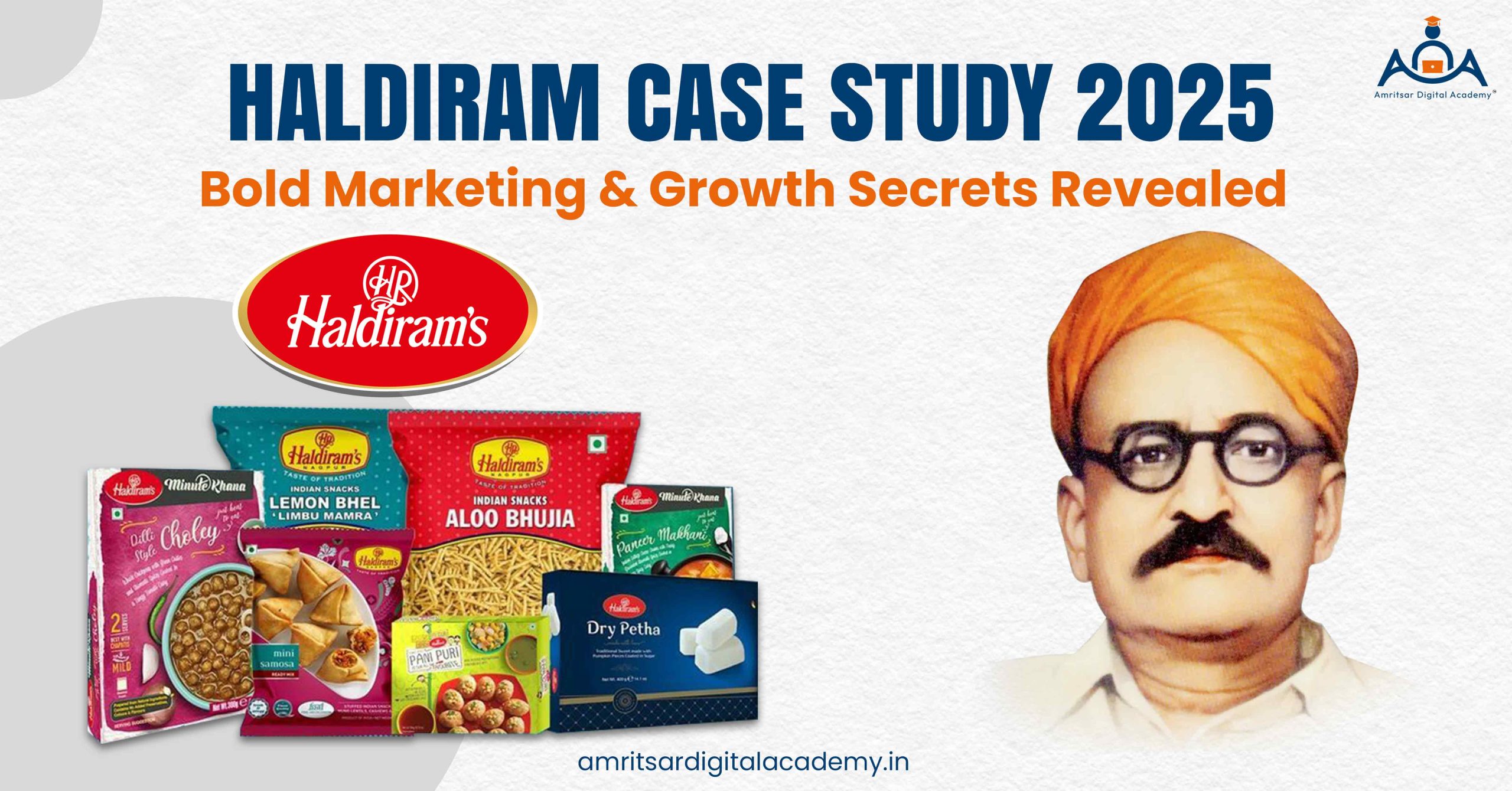When you think of Indian snacks, first name that comes to mind is Haldiram. Haldiram is not just a brand of snacks. With its traditional taste and quality this brand has transformed into India’s FMCG powerhouse with reach that now extends far beyond namkeens and sweets. This time we talk about Haldiram case study 2025 and will learn how this small sweet shop made multi billion dollar empire.
In this Haldiram case study, we cover—
- Haldiram: An Overview
- From Local Kitchens to Global Shelves: Haldiram Business Model
- Haldiram’s 4Ps: Product, Price, Place, Promotion
- Standout Marketing Strategies of Haldiram
- SWOT Analysis of Haldiram
- Key Growth Secrets Behind Haldiram’s Success
- End Note

Haldiram: An Overview
The story of Haldiram started in 1937 with small snack shop in Bikaner, Rajasthan by Ganga Bishan Aggarwal who is famously known as Haldiram. He started unique taste of bhujia with crunchiness which became popular among people. Competing with the likes of Nestle, ITC, and PepsiCo it commands strong position in India’s food and beverage sector.
Throughout the years, Haldiram has wanted to expand its business so it has set up production plants in different cities of India like Kolkata and Delhi. The company is now headquartered in Noida.
According to market report, Haldiram today enjoys market share of nearly 13-15% in India’s organized snack sector and is one of the most recognized Indian brands overseas. From the U.S. to the Middle East, its product line the shelves of Indian stores and even mainstream supermarkets. The brand exports to over 80 countries and making it true global ambassador of Indian flavors.
2025: The Bold Expansion Year
- 100 new products are launching this year like snacks, sweets, and ready to eat meals.
- They are entering 20 new countries, especially focusing on the US and Middle East.
- Big investors like Temasek and Alpha Wave Global are supporting them with $1 billion in funding.
- Haldiram is building modern factories to support this growth and improve production.
- In India they are starting franchise outlets in cities like Mumbai, Bangalore, and Chennai.
- They are also expanding into casual dining, kiosks, and quick service restaurants.
All these bold moves highlight why the Haldiram case study is so important for business students and entrepreneurs to learn from.
Haldiram Business Model Explained: Key Strategies & Growth Drivers
In this Haldiram case study, let’s discuss how Haldiram builds big empire with its well planned business model.
Core Business Model of Haldiram
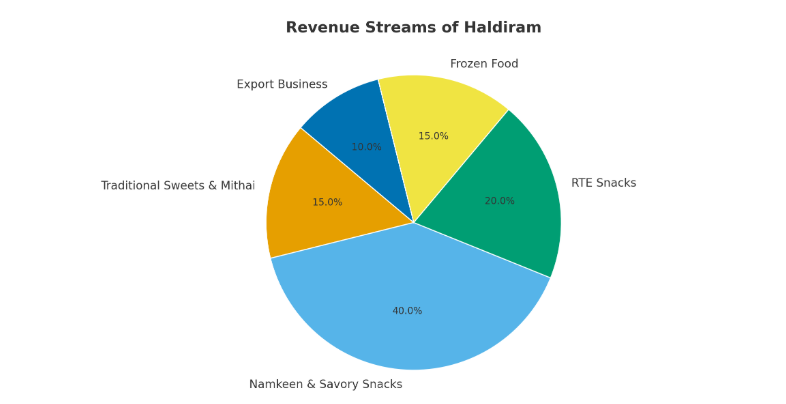
Haldiram business model mainly thrives on diversification. Their strategic approach of product diversification and innovation drives revenue, ensuring stability and scalability. Here are revenue streams of Haldiram:
Traditional Sweets and Mithai:
Haldiram offers variety of sweets according to regional preferences and festive occasions. Their diversification in sweets brings innovative fusion that appeals to modern consumers while maintaining traditional taste profiles.
Namkeen and Savory Snacks:
This segment is biggest contributor in generating revenue. The namkeen category has been their strongest differentiator and offering authentic regional flavors with consistent quality. From iconic Bhujia to innovative chat items, everything contributes to generating revenue.
RTE Snacks:
Haldiram recognizes changing lifestyles of people so they started to introduce ready to eat snacks. They heavily invested in RTE snacks like instant poha, upma, and various curries have captured the convenience seeking urban consumer segment effectively.
Frozen Food:
The frozen food segment includes ready to cook items like parathas, samosas, and complete meal solutions. This category has seen significant growth and especially post pandemic as consumers seek restaurant quality food at home.
Export Business:
Haldiram earns big part of its revenue from international sales. They create special products for each country but still keep the original Indian taste.
Omnichannel Retail Strategy
Haldiram strategically applies omnichannel retail strategy and their approach combines traditional retail presence with modern digital platforms:
Physical Retail Network: Haldiram operates in over 150 states across India. Each outlet is designed as experience center where customers can taste, purchase and even dine.
E-commerce Integration: The brand has strategically partnered with major online marketplaces like Amazon, Flipkart, and BigBasket while also developing its own direct to consumer (D2C) platform. Online sales now contribute approximately 25% of total revenue.
Modern Trade Presence: Haldiram’s products are easy to spot in big stores like supermarkets and hypermarkets. This helps them reach urban shoppers who like buying from well organized retail outlets.
Marketing Mix of Halidram (4Ps Analysis)
Haldiram 4Ps analysis includes product, price, place, and promotion. They target every age group and class of people as their potential customers.
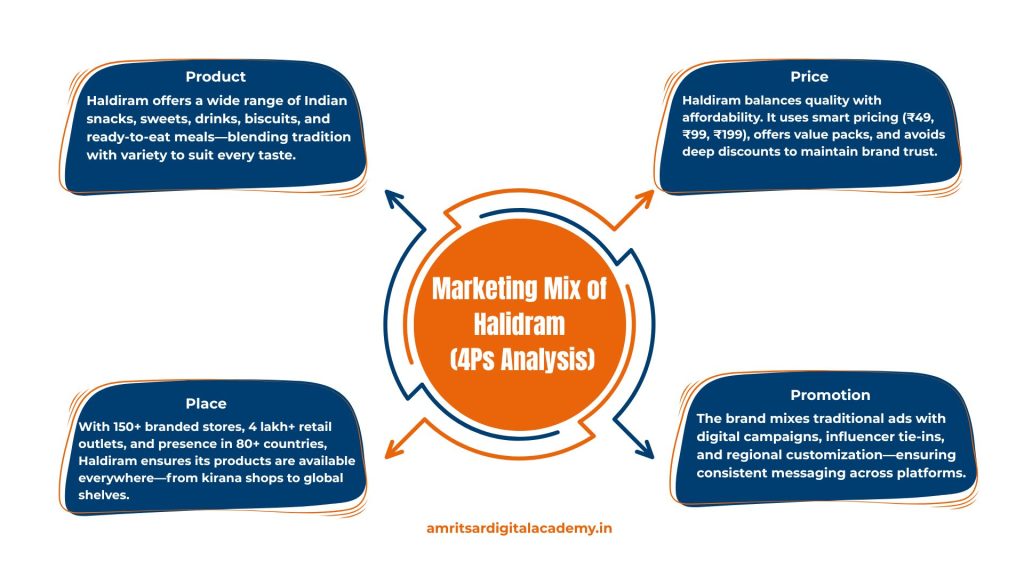
Here is 4Ps of Haldiram marketing mix:
Haldiram Product Strategy
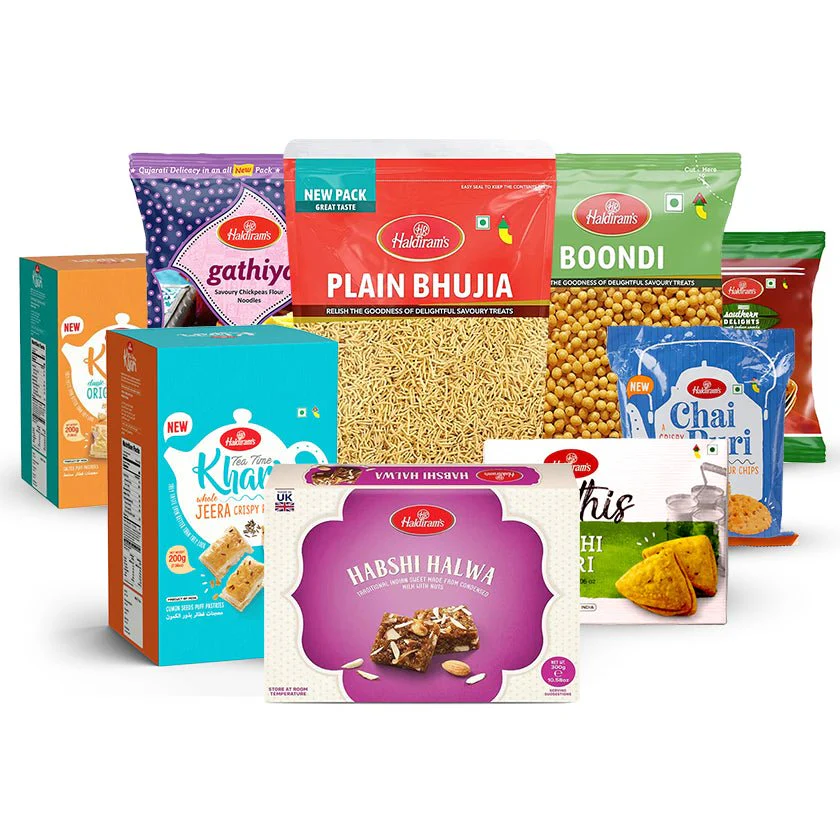
Haldiram is popular for its sweets and namkeen snacks. The Haldiram offers around 100 authentic food items in select markets and its sweet shops feature wide variety of options like—
| Namkeen | Sev, Mathri, Pancharatan Mixture, Navratan Mixture, Samosa, Aloo Bhujia, Moong Dal, Gol Kachori, Murukku, Lite Chidwa, Bhel, Aloo Lachha, Dry Fruit Mix, Chana Choor and Salted Kaju |
| Sweets | Mango Bite, Peanut Chikki, Rajbhog, Gulab Jamun, Soan Papdi, Kaju Katli, Badam Barfi, Rassagolla, Sandesh, Chamcham, Kesar sticks kulfi and Ice creams |
| Drinks | Orange Squash, Pineapple Squash, and Rose Sharbat |
| Biscuits | Kaju Butter, Pista Badam, and Kaju Nankhatai |
| Ready to Eat items | Punjabi Choley, Paw Bhaji, and Dal Makhni |
Haldiram Place Strategy
Haldiram distribution network has very strong presence to reach its customers everywhere. They work with distributors, retailers and online platforms to ensure smooth delivery and freshness. With over 150 branded stores and 4 lakh+ retail outlets, their products are available in cities, small towns, and even abroad in 80+ countries. Partnerships with big chains like D-Mart and Reliance Fresh, plus their own website and create seamless shopping experience. Their cold storage and inventory systems help keep products fresh and reduce waste.
Haldiram Pricing Strategy
Here are some key elements of Haldiram pricing strategy:
✅Haldiram positions itself as quality brand with prices that every class of customers can still afford.
✅They set prices based on product quality, competitor rates, and what customers feel the product is worth.
✅Small packs are priced for quick buys while larger packs offer better value for regular use. Gift boxes are priced higher during festivals.
✅They use prices like ₹49, ₹99, ₹199 to make products feel affordable.
✅They run discounts during festivals but avoid heavy price cuts to protect their brand image.
Haldiram Promotion Strategy
Haldiram marketing strategy is mix of traditional and modern promotion techniques. The combined strategy provides uniform brand communication through all platforms and accommodates customization based on audience own preferences and behaviors per platform.
How Haldiram Wins: Marketing Moves That Matter
Haldiram focuses on both traditional and modern marketing strategies to compete with its competitors in food and beverage industry. With the help of Haldiram case study, let’s explore successful marketing moves of Haldiram:
Marketing Campaigns of Haldiram
In every festive occasion, Haldiram is part of celebrations. Haldiram becomes peoples favorite during festive seasons. That’s why they create festive campaigns that highlight and celebrate our traditions. Here are popular marketing campaigns of Haldiram:
Pyaar Ka Tohfa
This campaign is designed to showcase emotional bond between siblings on the occasion of Raksha Bandhan. Their marketing strategy focuses on emotional storytelling to connect with indian family values. This campaign was promoted on different platforms across TV, YouTube, and social media platforms.
Khulke Khilao campaign
This campaign is based on Holi festival which is released on YouTube and social media. This campaign is great example of how Haldiram uses cultural moments to build emotional connections while promoting seasonal products.
Dhina Dhin Dha
Haldiram launched this marketing campaign to promote their restaurants. It is basically their first TV commercial focused on dining spaces. The Haldiram marketing campaign stands out because it focuses on the restaurant experience.
Digital Footprints of Haldiram
Haldiram adapts digital technologies and strategies very well. Haldiram offers D2C sales with full product range, gifting options, and regional menus through their own website. Their website gets organic traffic of 488.8k with good domain authority of 45.
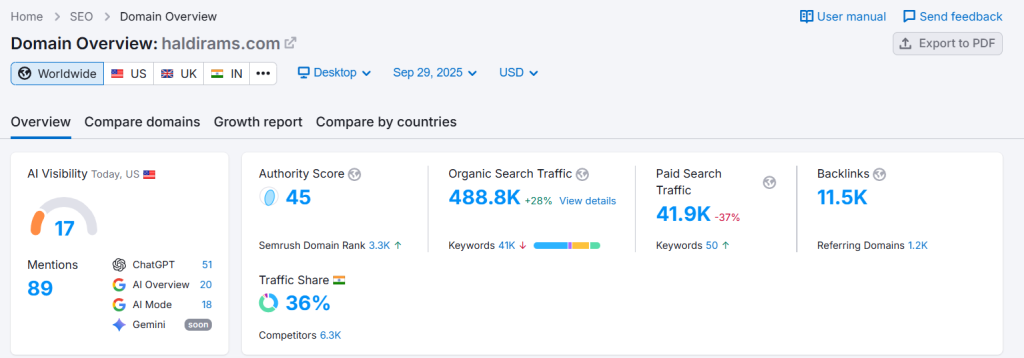
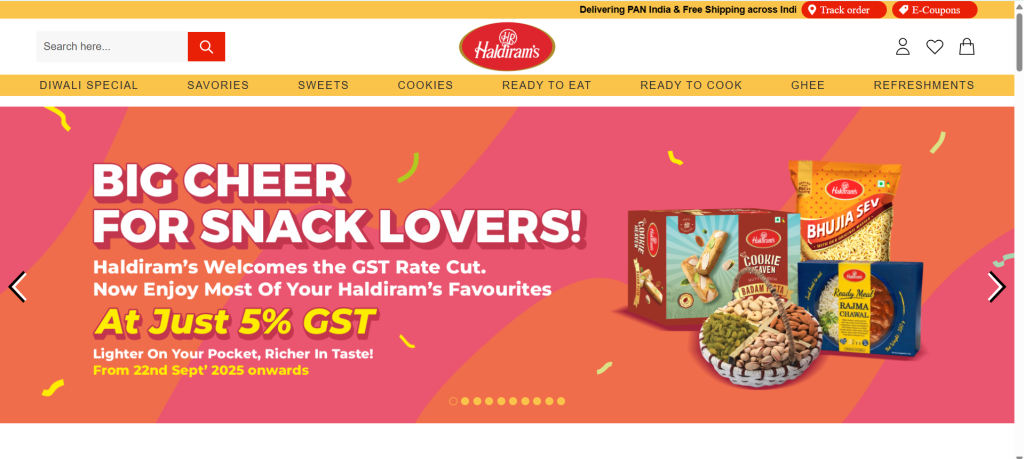
Social Media Marketing Strategies
They footprint their presence across social media platforms like Facebook, Instagram, and YouTube to target millennials and Gen Z.
➺Instagram Followers: 164k
➺Facebook Followers: 4.1k
➺YouTube Subscribers: 22.9k
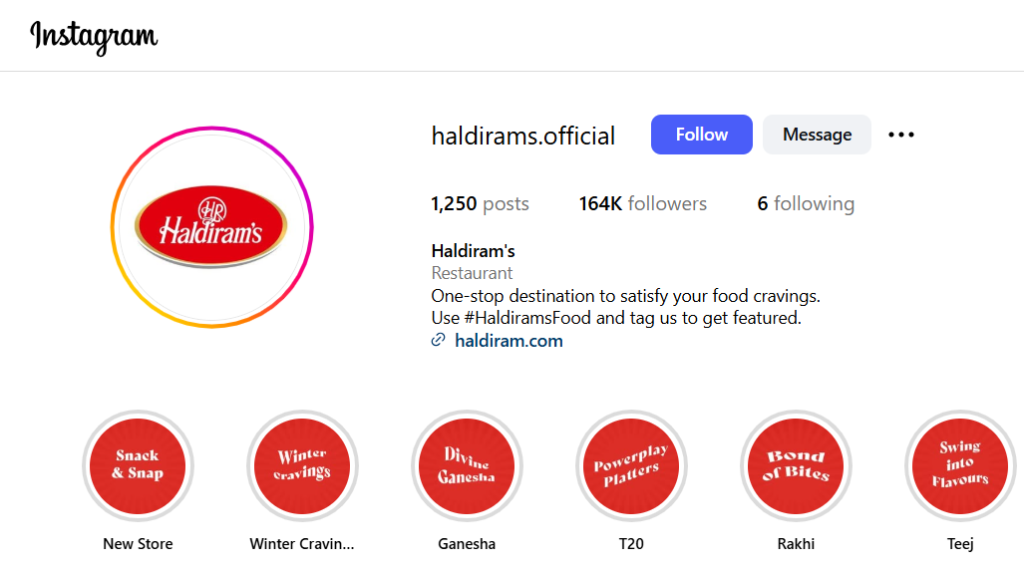
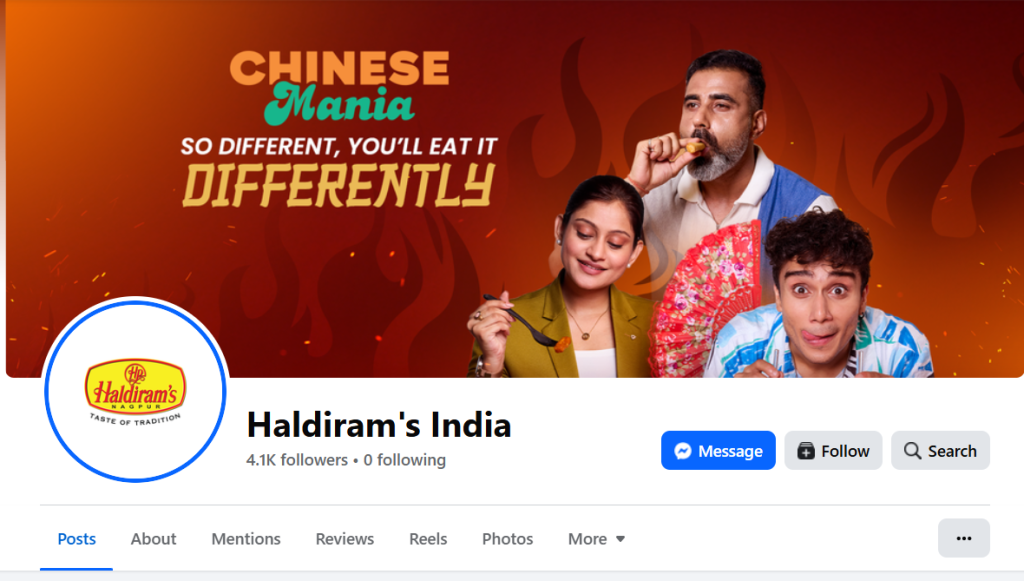

With engaging posts, contests, and reels on Instagram and Facebook showcasing product launches and festive offers build trust and transparency.
Influencer Marketing Strategies
Haldiram’s knows its audience well. Instead of relying only on celebrities, brand works with food bloggers, home chefs, and cultural influencers who truly connect with its values.
These micro influencers especially regional food lovers share honest reviews and personal experiences. Their content feels real and relatable, making it more effective than regular ads.
Regional Marketing Adaptation
Haldiram’s smartly applies its marketing strategies for different parts of India. They change their messages, product focus, and even packaging to match local tastes.
For Example
- In South India they highlight snacks that go well with local food.
- In North India they promote traditional favorites.
Their ads also use regional languages and cultural touches which help people feel more connected to the brand.
This strategy helps Haldiram retain its traditional Indian roots while appealing to Gen Z and millennials.
Also Read: Starbucks Case Study: Innovation In The Coffee Industry
SWOT Analysis of Haldiram
S= STRENGTHS
W= WEAKNESS
O= OPPORTUNITIES
T= THREATS
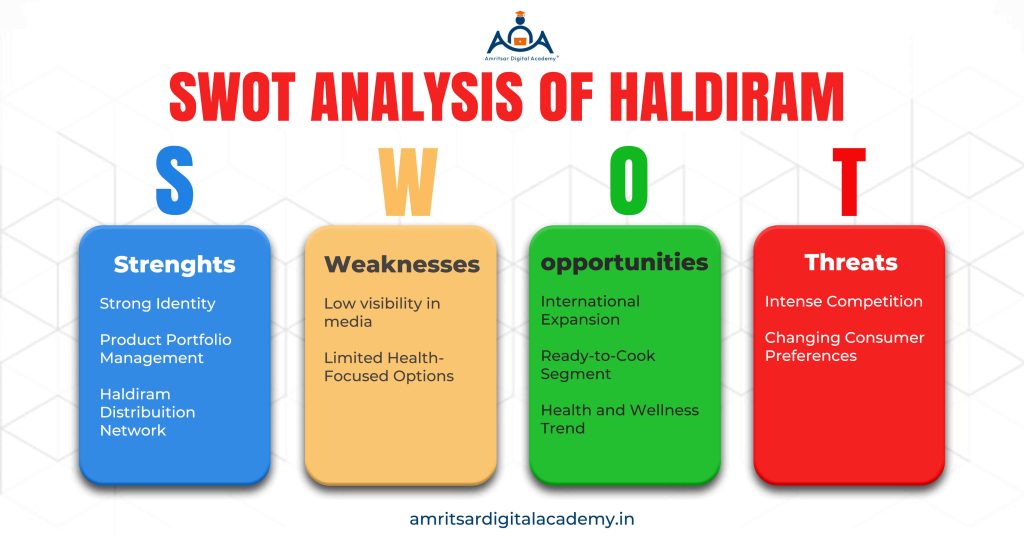
Strengths of Haldiram
- Strong Identity: Haldiram builds trust with its customers. Their quality and strong brand identity are their strengths now.
- Product Portfolio Management: Haldiram name is popular for its sweets and snacks. With large variety of product mix maintains its core identity.
- Haldiram Distribution Network: Their multi channel distribution approach ensures maximum market penetration across urban and rural areas, online and offline channels.
Weaknesses of Haldiram
- Low visibility in media: As compared to other bands, Haldiram has low presence in media. They need to focus on marketing campaigns to compete with their competitors.
- Limited Health Focused Options: There are limited options of healthy food segment in their product portfolio which have low capability to compete with other brands.
Opportunities of Haldiram
- International Expansion: Haldiram has great chance to grow globally especially in places where more Indians are living and people are curious about Indian food.
- Ready to Cook Segment: As cities grow and people’s lifestyles change there is more demand for easy and ready to eat meals.
- Health and Wellness Trend: Consumers are now aware of eating healthy so there is chance to create healthier versions of traditional foods.
Threats of Haldiram
- Intense Competition: Increasing competition from both organized players and local manufacturers threatens market share and pricing power.
- Changing Consumer Preferences: Consumer preferences have now changed, they want healthy food, which may have impact on demand for traditional food items.
This Haldiram case study highlights how strengths are maximized and weaknesses minimized for growth.
Key Growth Secrets Behind Haldiram’s Success
So what’s the magic recipe that makes Haldiram succeed? Here are the bold growth secrets revealed in this Haldiram case study:
Innovation in Flavors and Formats
From the classic bhujia to peri peri aloo bhujia, Haldiram constantly reinvents its products. Its ability to adapt Indian snacks to modern tastes is too good.
Early Adoption of Omnichannel Retail Strategy
Haldiram understood early on that customers shop everywhere. Its omnichannel retail strategy ensured seamless availability.
Trust Through Quality and Affordability
Consistency in taste and reasonable pricing built trust. Haldiram never compromised on quality and ensured customers return generation after generation.
Adapting to FMCG Marketing Trends in India
From adopting e commerce to engaging Gen Z on Instagram, Haldiram is quick to adapt. It does not just rely on traditional marketing but actively invests in digital storytelling.
End Note
The Haldiram case study is not just about how small sweet shop became global leader in FMCG market. It is a masterclass in business diversification, omnichannel strategies, innovative product portfolio management, and smart marketing.
As of 2025, Haldiram stands as shining example of how an Indian family business can compete with multinational FMCG leaders and win. The future is just as promising with possibilities in healthy snacks, millet foods, and global leadership.
For marketers and entrepreneurs, the moral is to innovate, remain relevant, trust building, and never underestimate the role of knowing your audience.
And the next time you open pack of Haldiram bhujia, recall that you are not only consuming snack but also relishing slice of India’s business success story.

